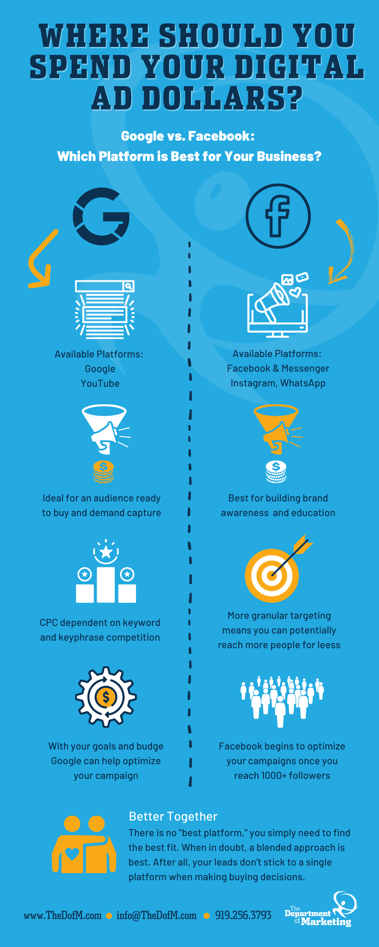You don’t have to commit to a massive budget in perpetuity to get the traffic you’re looking for, but PPC can help businesses that are new to marketing (or to a specific market) build awareness, traffic, and leads quickly while your other content marketing and SEO efforts ramp up.
Before, we discussed how much you should expect to spend on PPC, but which platform is best for your business?
 Google vs. Facebook
Google vs. Facebook
When it comes to paid media, the two platforms you’re likely considering are Google versus social media. And it’s no secret that Google (including YouTube) and Facebook (which these days also includes Facebook Messenger, Instagram and WhatsApp) are the biggest players in the pay-to-play space.
Which platform is right for you depends entirely on your product or service and your target audience. What are their preferred watering holes? Where do their go for information?
If they have a pulse, it’s safe to say they are using both Google and Facebook to make buying decisions. So we recommend a blended approach - not Google vs. Facebook, but Google and Facebook. But since that feels like a cop-out answer, we’ll break down a few additional considerations beyond, “Is your target alive?”
Your Campaign Goal
What goal do you want your ad dollars to help you achieve? It helps to know which stage of the buyer’s journey you want to target.
Do your buyers understand their problem? Are they currently looking for solutions that fit their needs? If you’re trying to reach people with strong intent - those people in your audience who are ready to buy - Google is probably the way to go. Google Ads are ideal for demand capture. After all, when you search just about anything on The Big G, the first results you see are products or services available for purchase.
However, if your buyers are more in the awareness or consideration stages, meaning they aren’t sure yet what solution they are looking for, consider starting with social media ads. Facebook ads are great for building brand awareness and sharing helpful information to help aid in the buying decision.
Of course, if you’re targeting people at each stage of the funnel, that is where our original recommendation comes in: use both.
Budget
There are a few things to consider when deciding where you should spend your ad dollars. There is no easy answer as to which platform is cheaper (is there ever?) because the price of ads is different based on so many factors, but there are a few things to keep in mind.
Google’s ad algorithm is based primarily on competition. So your CPC (or cost per click) is dependent on how competitive the keyword you are targeting is. If you’re in a very competitive industry or demographic area, your ad dollars simply aren’t going to go as far.
Facebook allows more granular targeting, so you can potentially reach more people on Facebook with the same budget.
Ease of Use
Google makes things pretty simple to get started. All you have to do is enter your goals and your budget, and the platform will basically take over and do the rest. Understanding how to translate your goals into something that Google can understand and optimizing your ads to improve engagement and decrease your cost over time is a whole different story. But for getting started, Google takes the W here.
Facebook is a bit more convoluted. Before you begin advertising on Facebook, it’s recommended that you have a healthy profile and strong presence. Why? Because Facebook relies on Lookalike Audiences to help you target your ads. The catch in creating a lookalike audience is that you need several hundred followers, email subscribers, or website visitors for the audiences to be accurate. If you’re a brand new brand, you might be better off starting with organic content on Facebook. If you have a particular post or offer that does well, you can always consider boosting that post to a broader audience without the numbers needed to create a more formal campaign.
TL; DR
Too long, didn’t read? There really is no best platform for advertising your business. Whether and where to advertise should be a part of your larger content marketing strategy. When in doubt, a blended approach is best. Digital marketing 101 says that you need to show up where your buyers are, and people do not stick to a single platform when making their buying decisions.
It can take dozens of touchpoints before someone commits to buying from you, and you better believe those touchpoints are occurring on both Google and social media. Ready to start strategizing your first paid campaign? The DofM can help.